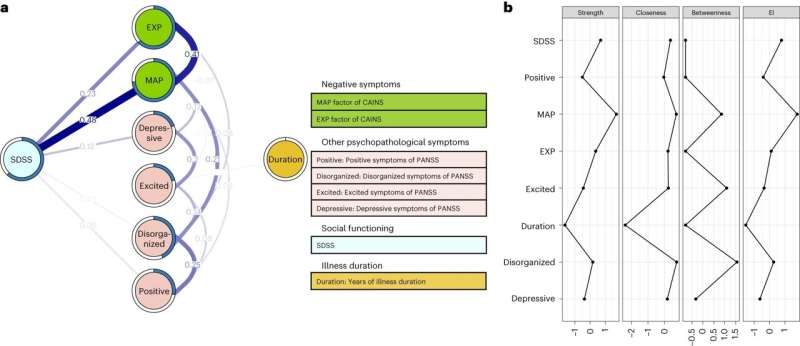This article has been reviewed according to Science X's editorial process and policies. Editors have highlighted the following attributes while ensuring the content's credibility:
fact-checked
peer-reviewed publication
trusted source
proofread
Motivation and pleasure deficits play an important role in social functioning across psychiatric disorders: Study

Dr. Raymond Chan's team from the Institute of Psychology of the Chinese Academy of Sciences and his collaborators have recently shown that amotivation and anhedonia, rather than expressive dysfunction, play a crucial role in determining the social functioning of schizophrenia patients.
The study was published in Nature Mental Health.
Negative symptoms refer to the loss of normal functioning, including anhedonia, avolition, alogia, asociality, and affective blunting, and have been shown to be the most important predictors of ultimate quality of life and functional outcome in patients with schizophrenia spectrum disorders.
Traditionally, negative symptoms have been seen as specific to schizophrenia spectrum disorders. However, recent evidence suggests that negative symptoms may be shared by other psychiatric disorders, such as major depressive disorder and bipolar disorder. Therefore, it is of clinical and theoretical interest to know whether amotivation and anhedonia, rather than expressive dysfunction, would have a similar impact on social functioning in a transdiagnostic sample.
To address such a knowledge gap, Dr. Raymond Chan's team and his collaborators conducted a transdiagnostic network analysis to specifically examine the network structure and interrelationship between negative symptoms, other psychopathologies and social functioning in 195 patients with schizophrenia, 92 patients with major depressive disorder, and 67 patients with bipolar disorder.
They assessed all the patients using two different tools. The Clinical Assessment Interview for Negative Symptoms and the Positive and Negative Syndrome Scale were used to evaluate symptoms and the Social and Occupational Functioning Assessment Scale were used to evaluate social functioning.
According to Dr. Chan, the amotivation and anhedonia factor played a central role in the transdiagnostic network at both symptom domain and symptom item levels.
In particular, the amotivation and anhedonia factor, rather than the expression factor, was strongly related to social functioning and made a greater contribution to social functioning in the entire sample.
However, a subsequent analysis revealed a different, interesting pattern among these relationships in major depressive disorder. Both the amotivation and anhedonia factor and the expression factor contributed equally well to the observed social functioning in patients with major depressive disorder, whereas the amotivation and anhedonia factor contributed most to the social functioning behavior observed both in patients with schizophrenia and with bipolar disorder.
This finding suggests that the impact on social functioning of these two domains of negative symptoms, i.e., the amotivation and anhedonia factor, and the expression factor, may differ among these three clinical groups. Therefore, a more specific and targeted intervention for social functioning is needed for these clinical groups.
Taken together, this study shows that the amotivation and anhedonia factor is strongly related to social functioning and accounts for a larger proportion of the variance in social functioning among a transdiagnostic sample of individuals with psychiatric disorders. Based on these results, the amotivation and anhedonia factor may be a potential intervention target for alleviating clinical symptoms and improving social functioning in schizophrenia, major depressive disorder, and bipolar disorder.
More information: Hu, Hx et al. A transdiagnostic network analysis of motivation and pleasure, expressivity and social functioning, Nature Mental Health (2023). DOI: 10.1038/s44220-023-00102-3. www.nature.com/articles/s44220-023-00102-3




















